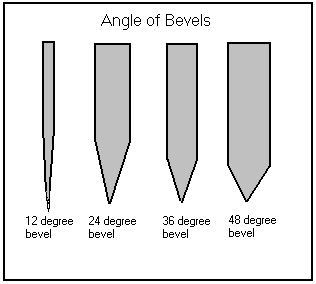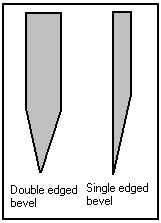 Acuity
is best explained by looking at an image containing the cross section of
the blade. In such an image the blade would have to come to a V shape at
the point of the final edge so that the knife can perform as a cutting
tool. The degree of angle of that final V shape at the edge can range from
12 to 50 degrees. A 12 degree bevel at the edge is strictly a slicing edge
as it is very thin and could not stand up to chopping and rough use. A
scalpel would have an edge of around 12 degrees. A 50 degree bevel rates
as a wedging edge and would be found on maul wedges and items used for
opening or slitting products. Most edge bevels are between 22 and 35
degrees. In this range, there is enough strength in the steel to keep the
edge smooth and the angle is acute enough to cut with relative ease. This
is the edge that belongs on utility and general purpose
Acuity
is best explained by looking at an image containing the cross section of
the blade. In such an image the blade would have to come to a V shape at
the point of the final edge so that the knife can perform as a cutting
tool. The degree of angle of that final V shape at the edge can range from
12 to 50 degrees. A 12 degree bevel at the edge is strictly a slicing edge
as it is very thin and could not stand up to chopping and rough use. A
scalpel would have an edge of around 12 degrees. A 50 degree bevel rates
as a wedging edge and would be found on maul wedges and items used for
opening or slitting products. Most edge bevels are between 22 and 35
degrees. In this range, there is enough strength in the steel to keep the
edge smooth and the angle is acute enough to cut with relative ease. This
is the edge that belongs on utility and general purpose
 knives 35
to 45 degrees A chopping edge-belongs on axes, cleavers and machetes.
The angle is not acute and slices soft materials poorly. 50 degrees A wedging bevel for maul ax and clam
knife. It is almost impossible to slice or cut with this edge
knives 35
to 45 degrees A chopping edge-belongs on axes, cleavers and machetes.
The angle is not acute and slices soft materials poorly. 50 degrees A wedging bevel for maul ax and clam
knife. It is almost impossible to slice or cut with this edge
The double edge bevel comes to a perfect V on the
cutting edge. This edge bevel is common to 70% of all cutting tools.
The single edge bevel is practical only when used along
with a straight edge bevel, but then is an excellent edge for slicing
since it characteristically cuts in a straight line. A V-shaped edge
sometimes has a tendency to wander. This is why most chisels used for fine
work are single edged.








